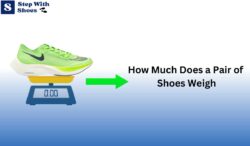Have you ever wondered how much your shoes weigh? It might seem silly, but it can actually be helpful to know! Most shoes weigh between 1 and 2 pounds for a pair. But, just like you wouldn’t wear flip-flops for a hike, different shoes are made for different things. Running shoes are usually super light, while big hiking boots are heavier to protect your feet.
Why does shoe weight matter?
- Comfort: Heavier shoes might make your feet tired faster.
- Purpose: You need lightweight shoes for running, but tough, heavier ones for hiking on rough trails.
If you’re curious about a specific pair of shoes, you can usually find their weight listed online!
Factors Affecting Shoe Weigh
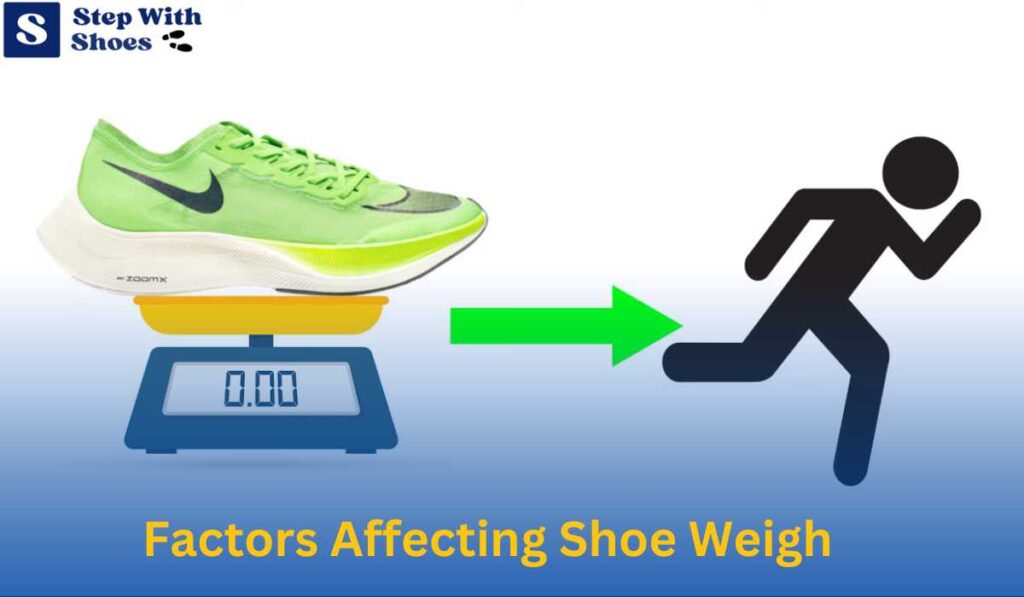
Have you ever wondered why some shoes feel lighter than others? The weight of a shoe can vary greatly depending on several factors. In this section, we will explore the key elements that contribute to the weight of a pair of shoes.
Materials Used
The materials used in shoe construction can significantly impact its weight. Here are some key points to consider:
- Leather: Leather is a common material used in shoes, known for its durability and comfort. However, it tends to be heavier than other materials.
- Synthetic fabrics: Shoes made from synthetic fabrics, such as mesh or nylon, are lighter than leather shoes. These materials are often breathable and provide flexibility.
- Rubber: The outsole of the shoe is typically made of rubber. Different types of rubber can vary in weight, with some lightweight rubbers available.
- Foam: Many shoes incorporate foam in their midsoles for cushioning. The density of the foam can affect the overall weight of the shoe.
Design Features
The design features of a shoe can also contribute to its weight. Consider the following points:
- Reinforcements: Shoes designed for specific activities, such as hiking or running, often have additional reinforcements in the form of overlays or thicker materials. While these reinforcements provide extra support, they can add to the shoe’s weight.
- Padded collars and tongues: Some shoes include extra padding around the collar and tongue for added comfort. However, this padding can increase the overall weight of the shoe.
- Extra features: Shoes with additional features, such as zippers, buckles, or decorative elements, may be heavier due to the added materials.
Size And Type Of Shoe
The size and type of shoe also play a significant role in determining its weight. Here’s what you should know:
- Size: Generally, larger-sized shoes will weigh more than smaller-sized ones, as they require more materials.
- Type of shoe: Different types of shoes have their own weight ranges. For example, athletic shoes are typically lighter than work boots due to their different purposes and designs.
The weight of a pair of shoes is influenced by various factors, including the materials used, design features, and size/type of the shoe. Understanding these factors can help you choose the right shoes that meet your specific needs without compromising comfort or performance.
So next time you try on a pair of shoes, remember that weight is more than just a number—it’s a result of careful craftsmanship and thoughtful design.
Understanding Common Shoe Weight Categories
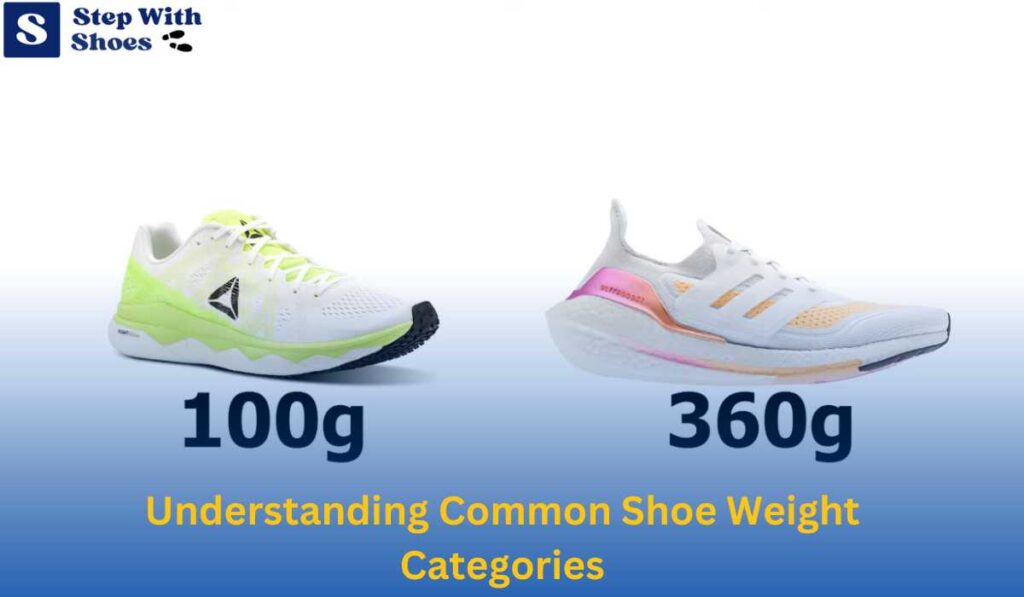
When it comes to buying a pair of shoes, most people focus on style, fit, and comfort. But have you ever considered the weight of the shoes you wear? Shoe weight can play a significant role in your overall comfort and performance, particularly in activities that require a lot of movement.
In this section, we will explore the three common categories of shoe weight: lightest shoes, moderate-weight shoes, and heaviest shoes.
Lightest Shoes
Lightweight shoes have been gaining popularity in recent years, especially among athletes and fitness enthusiasts. These shoes are designed to provide maximum comfort and minimal interference with natural foot movement. Key points about the lightest shoes include:
- Enhanced mobility: Lightest shoes are typically designed with reduced padding and extra flexibility, allowing for easy and unrestricted foot movement.
- Boosted performance: With less weight to carry, athletes can move faster and with less fatigue. Light shoes are particularly beneficial for long-distance running, where every ounce counts.
- Versatility: Light shoes can be suitable for a variety of activities, including running, walking, and gym workouts.
- Material choices: Lightweight shoes often incorporate advanced materials such as mesh, synthetic fibers, and even carbon fiber to reduce weight without compromising durability.
Moderate Weight Shoes
Moderate-weight shoes strike a balance between lightness and support. These shoes offer a slightly higher level of cushioning and stability compared to their lighter counterparts. Here are the key points to consider about moderate-weight shoes:
- Adequate support: Moderate-weight shoes often feature additional cushioning and support, making them suitable for people with specific foot conditions or those who prefer a bit more stability in their footwear.
- All-around performance: Whether you’re engaged in high-impact activities like cross-training or casual everyday walking, moderate-weight shoes can provide a comfortable and versatile option.
- Durability: Due to the materials used, moderate-weight shoes tend to offer better longevity than their lighter counterparts. This makes them a reliable choice for those seeking a long-lasting shoe option.
Heaviest Shoes
For certain sports or professions, the heaviest shoes may be the most appropriate choice. These shoes prioritize durability, protection, and stability over weight reduction. Here are the key points to consider about the heaviest shoes:
- Strength and stability: Heaviest shoes are often made with robust materials and feature reinforced toe caps and outsoles to provide maximum protection and support. This makes them suitable for demanding activities such as hiking, construction work, or heavy lifting.
- Specialized functions: Certain professions, like military personnel or firefighters, require footwear that can withstand extreme conditions and provide the necessary support. The heaviest shoes cater to these specific needs.
- Reduced mobility: While the heaviest shoes excel in durability and protection, they can be bulkier and less responsive compared to their lighter counterparts. As a result, they may not be the best choice for activities that require agility or speed.
The different categories of shoe weight can help you make an informed decision when selecting the right pair for your needs. Whether you prioritize speed, support, or durability, there is a shoe weight category that fits your preferences and requirements.
So, next time you go shoe shopping, don’t forget to consider the weight of the shoes you try on!
How Shoe Weight Impacts Performance
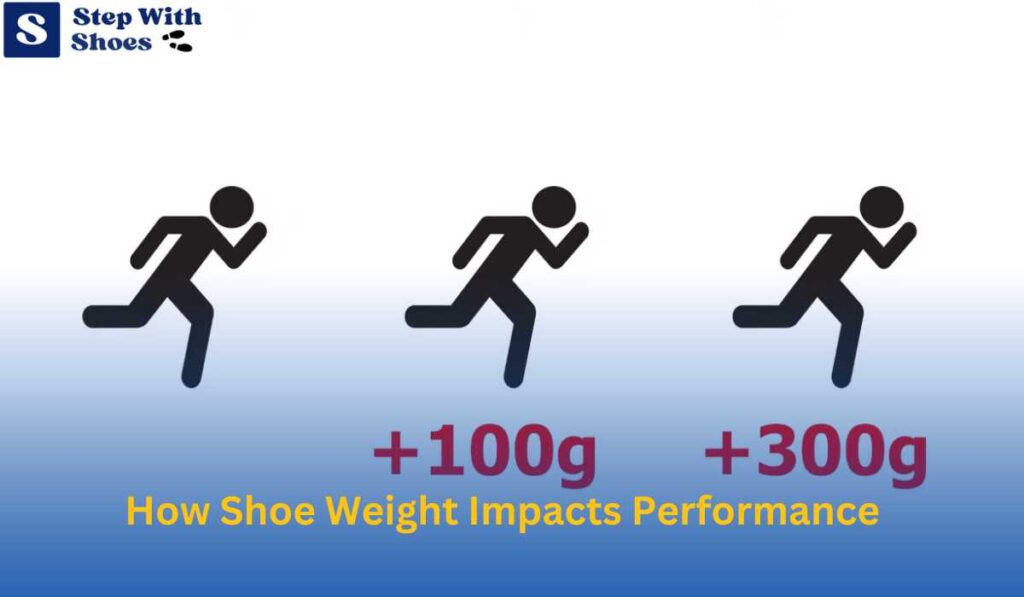
Running And Athletic Shoes
When it comes to running and athletic shoes, the weight of the shoe can have a significant impact on your overall performance. Here are some key points to consider:
- Lighter shoes: Running shoes that are lighter in weight are generally preferred by athletes and runners. The reduced weight of the shoe allows for increased speed and agility, making it easier to run for longer distances or participate in intensive workouts.
- Energy conservation: Lighter shoes require less energy to lift and move, allowing you to conserve your energy and maintain better endurance throughout your run or exercise routine.
- Reduced fatigue: Heavy shoes can contribute to muscle fatigue and increase the risk of injury. On the other hand, lightweight shoes create less strain on your muscles and joints, minimizing the chances of fatigue during prolonged activities.
- Flexibility and comfort: Lighter shoes offer greater flexibility and a more comfortable experience due to their reduced bulk and weight. This allows for better foot movement and natural strides, enhancing your overall performance.
Casual And Everyday Shoes
When it comes to casual and everyday shoes, weight plays a different role compared to athletic shoes. Consider the following:
- Comfort and support: Everyday shoes prioritize comfort and support over weight reduction. While lighter shoes are often preferred for athletic activities, everyday shoes tend to have more cushioning and support features to keep your feet comfortable throughout the day.
- Durability: Everyday shoes are designed to withstand daily wear and tear, so they may have additional materials and features that make them slightly heavier. This extra weight contributes to the durability and longevity of the shoe, ensuring it can endure the demands of daily use.
- Style: For casual and everyday shoes, weight may not be a significant factor in performance but can influence the overall aesthetic appeal. Lighter shoes may provide a sleeker look, while heavier shoes can contribute to a more substantial and substantial appearance.
Hiking And Outdoor Shoes
Hiking and outdoor shoes are a different breed altogether. Consider the following key points:
- Support and stability: Hiking shoes prioritize support and stability to withstand rugged terrains and uneven surfaces. This often means that they have a slightly heavier construction to provide the necessary protection and prevent foot and ankle injuries.
- Traction and grip: Hiking shoes require excellent traction and grip to navigate through various outdoor conditions. The weight of the shoe can contribute to the firmness and sturdiness needed to ensure a secure grip on slippery or uneven terrains.
- Durability and protection: Outdoor shoes, including hiking boots, may have additional layers and materials to provide durability and protect your feet from rocks, branches, and other potential hazards. These additional layers can add to the overall weight but are essential for outdoor activities.
The weight of your shoes can significantly impact your performance depending on the activity. Lighter shoes are favored for running and athletic pursuits, allowing for increased speed, agility, and reduced fatigue. Everyday shoes prioritize comfort and support over weight reduction.
For hiking and outdoor activities, shoes with slightly more weight provide essential stability, traction, and durability. Be sure to consider your specific needs and preferences when selecting the right pair of shoes for your chosen activity.
Tips For Choosing The Right Weight For Your Needs
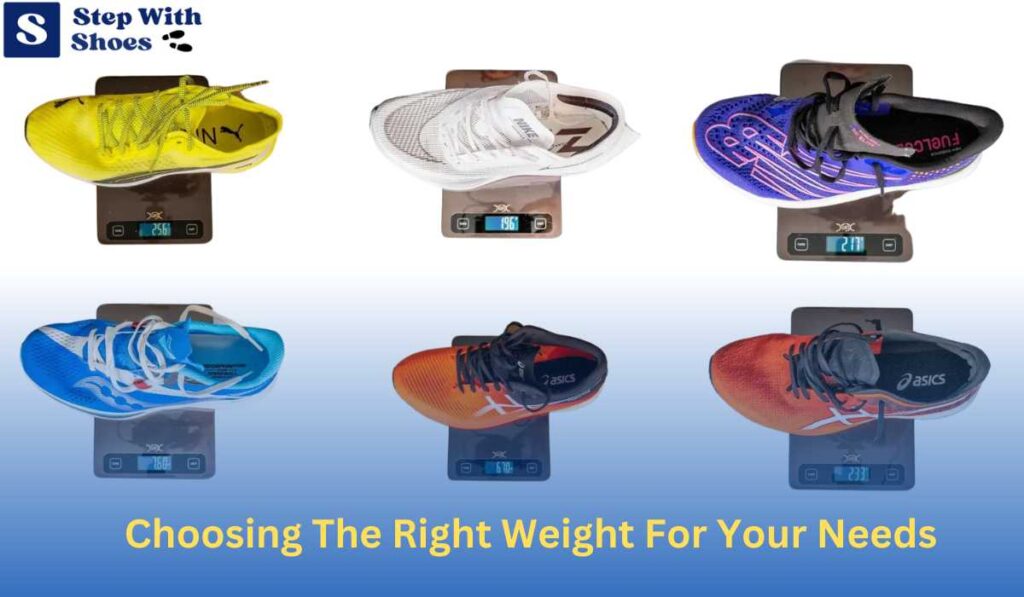
Consider Your Activity Level
- When choosing the weight of your shoes, it’s important to consider your activity level. Different activities require different levels of support and cushioning. Here are some tips to keep in mind:
- For high-impact activities like running or aerobics, opt for shoes with extra cushioning to absorb shock and reduce the risk of injury.
- If you’re into weightlifting or strength training, a heavier shoe may provide stability and support during your workouts.
- Lightweight shoes are usually more comfortable for everyday walking or casual activities and won’t weigh you down.
- Consider the terrain you’ll be on. If you’re going to be hiking or going off-road, you may need shoes with more support and durability.
- Remember that your shoe weight can affect your energy expenditure. Lighter shoes can help you conserve energy, especially during longer runs or activities.
Evaluate Comfort And Support
- Comfort should be a top priority when choosing the weight of your shoes. Here are some factors to consider:
- Look for shoes with a good fit. They should have enough space in the toe area to allow for natural movement without being too loose or too tight.
- Consider the arch support provided by the shoes. If you have high arches or flat feet, you may need shoes with extra support to prevent discomfort or pain.
- Pay attention to the cushioning of the shoes. It should provide enough shock absorption to protect your joints and prevent foot fatigue.
- Check if the shoes have a breathable upper material to keep your feet cool and dry during activities.
- Remember that comfort and support should never be compromised for the sake of weight. Find a balance that works best for your needs.
Look For Lightweight Alternatives
- If you’re interested in lighter shoes, here are some alternatives to consider:
- Minimalist shoes: These shoes have a minimal amount of cushioning and support, which can help strengthen your feet and improve your running form. However, they may not be suitable for everyone, especially those with preexisting foot conditions.
- Mesh or knit shoes: These shoes are made with lightweight and breathable materials, making them a popular choice for running and other athletic activities.
- Trail running shoes: These shoes are designed for off-road running and provide more stability and support in rough terrains while still being lightweight.
- Consider trying different brands and models to find the right balance between weight, comfort, and support for your needs.
- Ultimately, the weight of your shoes should be determined by your activity level, comfort, and personal preference. Take the time to try on different options and find the shoe weight that works best for you. Happy shoe shopping!
Maintaining Comfort Without Sacrificing Weight
—————————————————
Looking for the perfect pair of shoes means finding the right balance between comfort and weight. Nobody wants a heavy shoe that weighs them down, but at the same time, sacrificing comfort is not an option. This is why it’s crucial to consider different factors when choosing the right pair of shoes.
From cushioning to breathable options and shoe design, here are some key points to keep in mind:
Choosing The Right Cushioning
When it comes to maintaining comfort without sacrificing weight, the type of cushioning in your shoes plays a significant role. Here are a few options to consider:
- Foam cushioning: Shoes with foam cushioning provide excellent shock absorption and comfort while keeping the weight to a minimum. Look for shoes with lightweight foam compounds like ethylene-vinyl acetate (EVA) or polyurethane (PU) foam.
- Gel cushioning: Gel cushioning, typically made of silicone or similar materials, offers excellent support and impact absorption. These shoes tend to be lightweight, making them a popular choice for those seeking comfort without extra weight.
- Air cushioning: Shoes featuring air cushioning technology utilize air-filled chambers or pockets in the midsole to provide a lightweight and responsive feel. Air cushioning offers a good balance between comfort and weight, making it a popular choice for many athletes.
- Minimalist cushioning: For those who prefer a barefoot-like experience, minimalist shoes offer minimal cushioning. These shoes are lightweight and provide a more natural, less bulky feel.
Exploring Breathable Options
Comfort and breathability go hand in hand, especially when it comes to shoes. Here are a few breathable options to consider:
- Mesh uppers: Shoes with mesh uppers allow for better airflow, keeping your feet cool and preventing excessive sweat. Mesh is a lightweight material that promotes breathability without compromising durability.
- Ventilated designs: Some shoe models feature specific ventilation ports or perforations in the upper material, allowing air to circulate freely. This feature enhances breathability and keeps your feet dry during intense activities.
- Moisture-wicking linings: Look for shoes with moisture-wicking linings, as they help to control sweat and prevent odor-causing bacteria. These linings can be made of fabrics like mesh, nylon, or moisture-wicking synthetic materials.
Finding A Balanced Shoe Design
Apart from cushioning and breathability, the overall shoe design plays a vital role in maintaining comfort without sacrificing weight. Consider the following factors:
- Lightweight materials: Opt for shoes made with lightweight materials, such as synthetic fabrics or lightweight leather. These materials contribute to lighter overall shoe weight.
- Flexible construction: Shoes with a flexible construction allow for natural foot movement and provide a comfortable wearing experience. Look for shoes with flexible outsoles and uppers that can bend and move with your feet.
- Arch support: A well-designed shoe should offer adequate arch support to prevent discomfort and provide stability. Look for shoes with built-in arch support or the option to add custom orthotics if needed.
When searching for shoes that maintain comfort without sacrificing weight, it’s essential to consider various factors such as cushioning, breathability, and shoe design. By choosing the right cushioning, exploring breathable options, and finding a balanced shoe design, you can ensure a comfortable and lightweight experience, giving you the freedom to move with ease.
So, next time you shop for shoes, keep these tips in mind to find your perfect match.
Comparing Weight Across Brands And Models
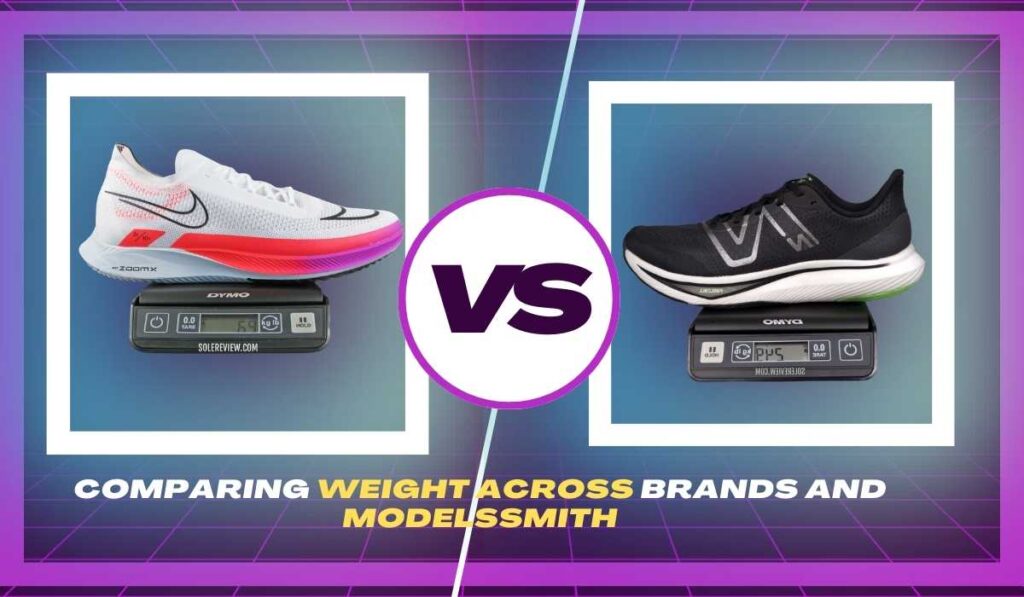
Popular Shoe Brands And Their Average Weights
When it comes to buying a new pair of shoes, their weight is an important factor to consider. The weight of your shoes can impact your comfort level, especially if you’ll be wearing them for extended periods. Different shoe brands and models have varying weights, depending on their design, materials used, and intended purpose.
Here are the average weights of popular shoe brands:
- Nike:
- Running shoes: 9-12 ounces
- Basketball shoes: 12-14 ounces
- Casual shoes: 8-10 ounces
- Adidas:
- Running shoes: 8-11 ounces
- Soccer cleats: 7-10 ounces
- Tennis shoes: 10-12 ounces
- New Balance:
- Running shoes: 8-11 ounces
- Walking shoes: 9-12 ounces
- Cross-training shoes: 10-13 ounces
- Puma:
- Running shoes: 8-10 ounces
- Soccer cleats: 6-9 ounces
- Lifestyle shoes: 9-11 ounces
- Reebok:
- Running shoes: 9-11 ounces
- Cross-training shoes: 10-13 ounces
- Classic sneakers: 11-14 ounces
It’s important to note that the weight of shoes can vary within each brand and even between different models within the same brand. These averages can help give you a general idea, but it’s always a good idea to check the weight specifications of specific shoes you are interested in before making a purchase.
Factors To Consider When Comparing Shoe Weights
When comparing the weights of different shoe brands and models, there are several factors to consider. Here are some key points to keep in mind:
- Shoe type: Different types of shoes have different weight ranges. Running shoes tend to be lighter compared to basketball shoes or hiking boots. Consider the purpose of the shoes and the activities you’ll be doing while wearing them.
- Material: The materials used in the upper, midsole, and outsole of the shoe can significantly affect its weight. Lightweight materials like mesh, synthetic fabrics, and foam are often used to reduce weight without compromising durability.
- Cushioning and support: Shoes with more cushioning and support tend to be heavier. Consider your specific needs for comfort and stability, and find a balance between weight and the level of support provided.
- Foot size: The size of your feet can also impact the weight of your shoes. Larger shoe sizes often have slightly more material, resulting in a slightly higher weight.
- Personal preference: Ultimately, your preference plays a significant role in determining the right shoe weight for you. Some individuals prefer lighter shoes for extra speed and agility, while others prioritize stability and support.
When comparing shoe weights, it’s essential to consider these factors in conjunction with your specific needs and preferences. By doing so, you can make an informed decision and choose a pair of shoes that will provide the right balance of weight, comfort, and performance for you.
How to Measure Shoe Weight
Explaining the tools and methods for measuring shoe weight accurately
To measure the weight of a pair of shoes accurately, you’ll need the right tools and a reliable method. Here’s how to do it:
- Tools: You can use a digital kitchen scale, which provides precise measurements in grams or ounces. Ensure the scale is calibrated correctly before use.
- Method: Place a clean, flat surface (like a tray or a piece of cardboard) on the scale’s platform. Then, position both shoes side by side on the surface, making sure they are evenly distributed on the scale.
- Avoid stacking or overlapping the shoes, as this can lead to inaccurate measurements.
- After the shoes are correctly positioned, read the weight displayed on the scale.
- To ensure accuracy, measure a few times and calculate the average weight for the pair. By using this method and a reliable digital scale, you can confidently determine the exact weight of your shoes.
Importance of weighing both shoes together
Weighing both shoes together might seem obvious, but it’s crucial to understand why this is important:
- Considers Variations: Each shoe in a pair may not be identical in weight due to manufacturing differences, slight irregularities, or variations in material thickness.
- Realistic Representation: Measuring both shoes together provides a more accurate representation of the weight you’ll carry when wearing them. This is essential for assessing comfort and performance.
- Accounts for Additional Factors: Weighing both shoes together accounts for any extra elements like laces, insoles, or custom orthotics, which can collectively impact the overall weight and comfort of your footwear.
Measuring both shoes together provides a comprehensive perspective on the weight you will bear, enabling informed decision-making during the shoe selection process. Additionally, this approach facilitates the evaluation of their influence on both comfort and performance. This fundamental yet crucial measure guarantees the availability of precise information to determine the most suitable pair of shoes that aligns with your requirements.
Notable Innovations In Lightweight Shoe Technology
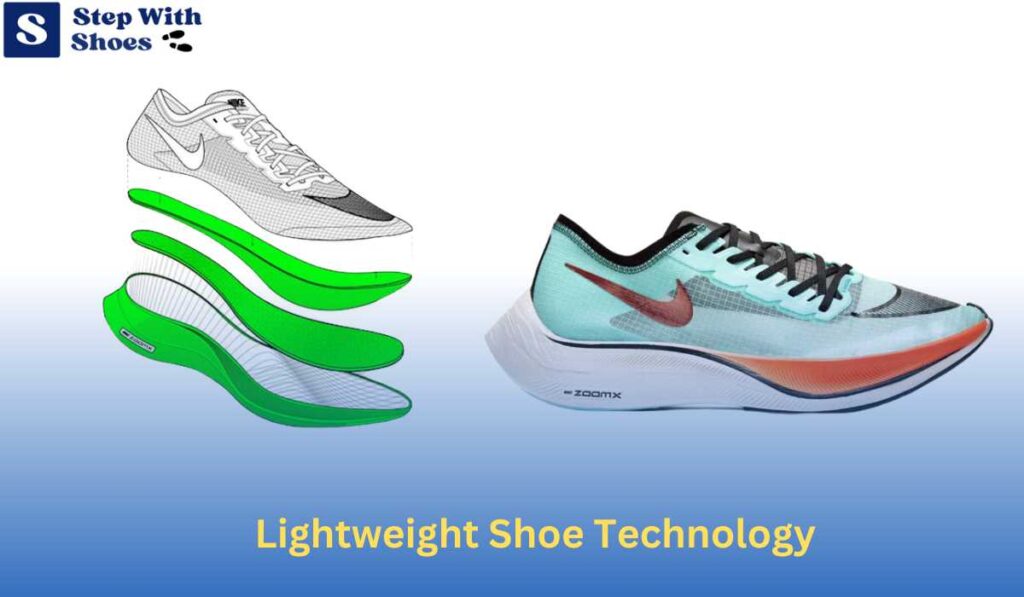
Advances In Materials
In recent years, there have been significant advancements in shoe technology that have revolutionized the weight of footwear. Manufacturers have been experimenting with various materials to create lightweight shoes without compromising on comfort or performance. Here are some key points:
- Use of lightweight synthetic fabrics: One of the most significant innovations in shoe technology is the use of lightweight, synthetic fabrics such as nylon and mesh. These materials are not only breathable but also incredibly lightweight, reducing the overall weight of the shoe.
- Integration of carbon fiber: Carbon fiber has become a popular choice for shoe manufacturers due to its strength and low weight. By incorporating carbon fiber plates or layers into the shoe’s design, manufacturers can create lightweight yet supportive shoes for athletes and everyday wearers alike.
- Foam-based midsoles: Traditional midsoles made of rubber or other heavy materials have been replaced with foam-based alternatives. These foams are not only lighter but also provide excellent cushioning and energy return, allowing for more comfortable and efficient movement.
Impact Of New Manufacturing Techniques
Alongside advancements in materials, new manufacturing techniques have also contributed to the development of lightweight shoes. These techniques have made it possible to create shoes that are lighter, more flexible, and better fitting. Consider the following:
- 3D printing: With 3D printing technology, manufacturers can create intricate shoe components with precise measurements, eliminating any excess material and reducing weight substantially. It also allows for customization, enabling shoes to be tailored to individual needs.
- Seamless construction: Traditional shoe manufacturing involves multiple pieces stitched together, adding weight and potential discomfort. However, advancements in seamless construction techniques have eliminated the need for excessive stitching, resulting in lighter and more comfortable shoes.
- Laser cutting: Laser cutting technology allows manufacturers to precisely cut shoe components without excessive material waste. This technique offers the flexibility to create intricate patterns and designs while reducing unnecessary weight.
Future Trends In Shoe Weight
The pursuit of lighter shoes is an ongoing focus for manufacturers across the industry. As technology continues to advance, we can expect to see even more innovations in reducing shoe weight. Here are some potential future trends:
- Advancements in sustainable materials: With growing environmental concerns, manufacturers are exploring eco-friendly and lightweight materials. Bio-based alternatives and recycled materials may become more prevalent, offering a lighter and more sustainable shoe option.
- Integration of smart technology: The future of shoe weight may be intertwined with smart technology. By incorporating sensors and microchips, manufacturers may be able to create intelligent shoes that adapt to individual needs, potentially reducing unnecessary weight while maximizing comfort and performance.
- Further improvements in 3D printing: As 3D printing technology continues to evolve, we can expect to see even more precise and intricate shoe designs. This advancement will allow for further weight reduction and increased customization options.
Notable innovations in lightweight shoe technology have brought about significant improvements in both materials and manufacturing techniques. With advancements in materials like lightweight synthetic fabrics and carbon fiber, along with new manufacturing methods such as 3D printing and laser cutting, shoes are becoming lighter, more comfortable, and better fitting than ever before.
As technology progresses, we can look forward to even more exciting developments in reducing shoe weight and enhancing overall performance.
Frequently Asked Questions
How Much Does A Typical Pair Of Shoes Weigh?
A typical pair of shoes weighs between 1 to 2 pounds. However, the weight can vary depending on the type of shoe, materials used, and size.
What Factors Can Affect The Weight Of Shoes?
Several factors can affect the weight of shoes, including the type of materials used, the size of the shoe, the amount of cushioning or support, and any additional features like extra grip or waterproofing.
Are Lighter Shoes Better For Running Or Sports Activities?
Lighter shoes are generally preferred for running and sports activities as they can help improve speed and agility. However, it’s important to find a balance between weight and support to ensure proper comfort and stability during performance.
Conclusion
The weight of a pair of shoes can vary significantly depending on various factors such as the materials used, the style of the shoes, and the size. While it may seem like a trivial aspect, the weight of shoes can have a significant impact on comfort and performance.
It is important for individuals to understand the weight of their shoes, especially if they participate in activities that require agility and speed. Lighter shoes are generally more desirable, as they can enhance mobility and reduce fatigue. However, it is also crucial to strike a balance between weight and durability, as overly lightweight shoes may lack the necessary support and protection.
Ultimately, finding the right shoe weight is a personal preference that should be based on individual needs and preferences. So, next time you shop for a pair of shoes, consider their weight and how it may affect your overall experience.

